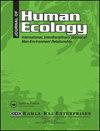Livelihood, Sustainability and Change among Changpas of Changthang: Ladakh India
Q4 Environmental Science
引用次数: 0
Abstract
Pastoral societies use animals as providers of food, fuel, fiber, draught power and transportation. However, nomadic, semi- nomadic and transhumant pastoralist societies have lifestyles that revolve mainly around their livestock. The transhumant pastoral societies inhabiting the high Himalayan areas exploit the seasonal abundance of grazing areas. As social and ecological conditions change, pastoralists adjust accordingly. Contrary to their reputation, pastoralists have traditional practices for conserving vegetation by rotational grazing. Pastoralists make a significant contribution to India’s economy in terms of food security (milk), provision of draft animal power, as well as foreign exchange earnings (meat, fiber for example, pashmina wool). Since pastoralists do not own land, their produce is generated by dependence on communally and state owned grazing land. Currently, the trend towards globalization of the market, with pastoral lands increasingly being commercialised and/or turned in to national parks, has created problems for the pastoralists. Since Independence of India, the pastoralists of the Himalayas have faced a series of significant changes from external, political and economic changes. These structural alterations have brought adjustments in many aspects of the traditional pastoral system, including migratory cycle, local economy and social organisation. Many of them left their traditional transhumant way of life and settled along valleys. Some have settled in urban areas, others stick to the pastoral activities by changing the composition of livestock by increasing number of goats and decreasing number of yaks. All pastoral groups in Himalaya face the similar constraints and stimuli. Natural exigencies, extreme weather conditions, drought, epidemics and predators, result in reduction of animals. Likewise, social crisis, such as phases in domestic developmental cycle and work force shortage in herding groups cause concern in the community. An attempt has been made to study the change and problems faced by the area- Changthang and people- Changpas due to the development programs of the government agencies of the state.印度拉达克昌塘昌坝的生计、可持续性和变化
游牧社会使用动物作为食物、燃料、纤维、动力和交通工具的提供者。然而,游牧、半游牧和游牧社会的生活方式主要围绕着他们的牲畜。居住在喜马拉雅高海拔地区的游牧社会利用了季节性丰富的牧区。随着社会和生态条件的变化,牧民也会做出相应的调整。与他们的名声相反,牧民有通过轮牧来保护植被的传统做法。牧民在粮食安全(牛奶)、畜力供应以及外汇收入(肉类、纤维,例如羊绒)方面为印度经济做出了重大贡献。由于牧民没有土地,他们的产品依赖于公有和国有的牧场。目前,市场全球化的趋势,牧区越来越商业化和/或变成国家公园,给牧民带来了问题。自印度独立以来,喜马拉雅山脉的牧民面临着一系列来自外部、政治和经济变化的重大变化。这些结构性的变化给传统牧区系统带来了许多方面的调整,包括迁移周期、地方经济和社会组织。他们中的许多人离开了传统的迁移生活方式,沿着山谷定居下来。一些人定居在城市地区,另一些人则通过增加山羊的数量和减少牦牛的数量来改变牲畜的组成,坚持游牧活动。喜马拉雅所有的牧区都面临着类似的约束和刺激。自然紧急情况、极端天气条件、干旱、流行病和捕食者导致动物数量减少。同样,社会危机,如家庭发展周期的阶段和牧民群体的劳动力短缺,也引起了社会的关注。本文试图研究由于国家政府机构的发展计划,昌塘地区和昌帕斯人所面临的变化和问题。
本文章由计算机程序翻译,如有差异,请以英文原文为准。
求助全文
约1分钟内获得全文
求助全文
来源期刊

Journal of Human Ecology
Environmental Science-Ecology
自引率
0.00%
发文量
14
期刊介绍:
The Journal of Human Ecology publishes empirical and theoretical research, short notes and brief communications probing the interface between human beings and their environment. The journal also has a section dedicated to reviews. The contributions combine ideas and methods from several disciplines, including, but not confined to, physical anthropology, health awareness, sustainability and development, sociology, forestry, psychology and agriculture. The journal also accepts research that focuses on the well-being of those with physical or mental challenges, the importance of food safety, measures taken to improve public health, and the sociological aspect of human ecology.
 求助内容:
求助内容: 应助结果提醒方式:
应助结果提醒方式:


